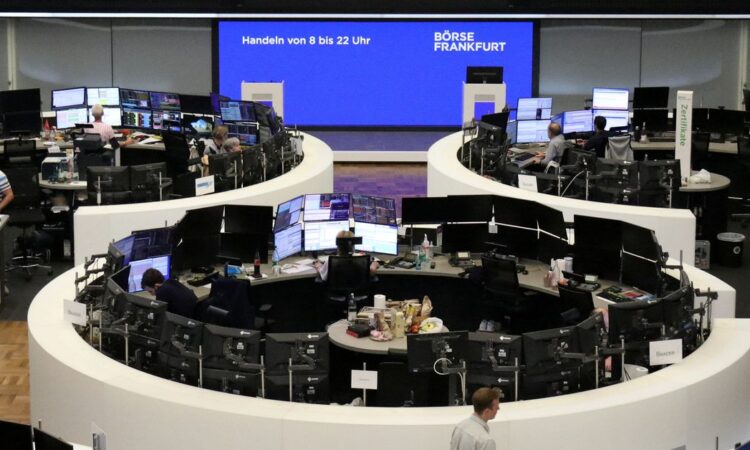
[1/2]The German share price index DAX graph is pictured at the stock exchange in Frankfurt, Germany, August 18, 2023. REUTERS/Staff/File Photo Acquire Licensing Rights
Aug 21 (Reuters) – European stocks edged higher on Monday after a rout last week while government bond yields renewed their rise as oil prices firmed even as China delivered smaller rate cuts than investors expected.
China’s central bank trimmed its one-year lending rate by 10 basis points and left its five-year rate unmoved. That was a surprise to analysts who had expected cuts of 15 basis points to both as recovery in the world’s second largest economy has lost steam due to a worsening property slump, weak spending and tumbling credit growth.
“The small injection of stimulus by China’s central bank in the ailing economy has proved largely underwhelming given the scale of the challenges erupting across sectors, but it has given investors hope there could be more to come,” said Susannah Streeter, head of money and markets at Hargreaves Lansdown.
“There is still some expectation that Chinese authorities will step in with a more generous boost, but it appears the weakness of the yen appears to be stemming more immediate action,” Streeter added.
While disappointment sent Asian shares lower, with Chinese blue chips (.CSI300) falling 0.4% to the lowest in almost nine months and other Asian indexes also dropping, European shares opened higher.
Europe’s STOXX 600 (.STOXX) index was up 0.7% by 0914 GMT, following last week’s 2.3% drop, with energy companies outperforming as oil prices rose with tightening supply from Saudi Arabia offsetting demand concerns. U.S. stock futures were also higher. ,
Oil prices edged higher on Monday after snapping a seven-week winning streak last week on concerns about Chinese demand. Brent was last up 36 cents at $85.16 a barrel, while U.S. crude was 41 cents higher to $81.66 per barrel.
In bond markets, a sell-off that sent government borrowing costs to their highest in over a decade regained impetus on Monday.
Longer-dated U.S. Treasury yields were up another 3-4 basis points on Monday with the 30-year yield touching a fresh 12-year high at 4.44%.
The key event for the week is the U.S. Federal Reserve’s Jackson Hole conference, where markets assume chair Jerome Powell will note the jump in yields and the recent run of strong economic data. The Atlanta Fed’s GDP Now tracker is running at a heady 5.8% for this quarter.
“It’s an opportunity for Powell to give an updated assessment on economic conditions, which now appear stronger than anticipated and reinforce the case for additional rate hikes,” Barclays analyst Marc Giannoni said.
“Even so, we would be surprised if he provided specific guidance, with key August prints for employment, CPI and retail sales all to come before the September meeting.”
A majority of polled analysts think the Fed is done hiking, while traders are betting on just under a 40% chance of a final Fed hike by November.
The U.S. dollar, which has notched five weeks of gains helped by rising bond yields, was trading flat on Monday against a basket of peers, just below two-month highs touched on Friday.
The euro was up 0.2% against the dollar after last week’s 0.7% loss.
The ascent of the dollar and yields was weighing on gold at $1,888 an ounce , having touched a five-month low last week.
Prices for liquefied natural gas (LNG) were underpinned by the risk of a strike at Australian offshore facilities that could affect around 10% of global supply. Europe’s benchmark TTF front-month wholesale gas contract was up 3% at 38.75 euros, compared to early August’s 43 euro peak.
Earnings were also in focus with shares in Dutch payments processor Adyen (ADYEN.AS) dropping another 6% on Monday, putting them on track for a 48% drop over the last three sessions, following Thursday’s weak earnings which raised concerns around its valuation.
Earnings from AI-darling Nvidia (NVDA.O) on Wednesday will be another major test of valuations.
Reporting by Yoruk Bahceli and Wayne Cole; Editing by Shri Navaratnam, Himani Sarkar and David Evans
Our Standards: The Thomson Reuters Trust Principles.





